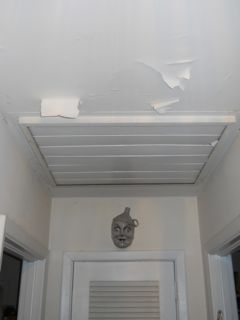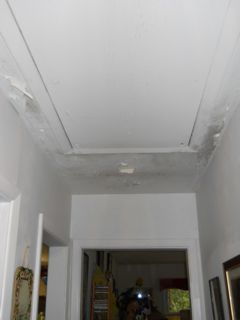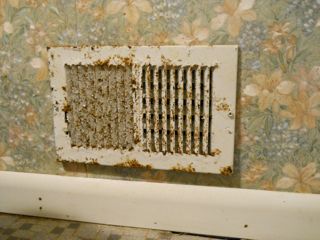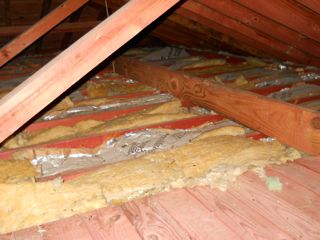Mystery of the Peeling Ceiling – A Building Science Whodunit

 Yesterday we took our HERS rater class out into the field to get experience with the pressure testing equipment and data collection procedures. As a bonus, the house we visited presented us with an interesting mystery. Here are the symptoms and conditions we found, along with some photos.
Yesterday we took our HERS rater class out into the field to get experience with the pressure testing equipment and data collection procedures. As a bonus, the house we visited presented us with an interesting mystery. Here are the symptoms and conditions we found, along with some photos.
Yesterday we took our HERS rater class out into the field to get experience with the pressure testing equipment and data collection procedures. As a bonus, the house we visited presented us with an interesting mystery. Here are the symptoms and conditions we found, along with some photos.
First, as you can see in both of the first two photos, the paint was peeling from the ceiling in the hallway. It wasn’t peeling anywere else in the home, just in the hallway. Also, the hallway ceiling has both a whole-house fan and pull-down attic stairs. At the end of the hallway, you can see the louvered door, behind which is an atmospheric combustion, natural draft gas water heater.

In the floor of the hallway was a large, central return vent for the furnace and air conditioner duct system. It was the only return vent for the whole house.

The supply vent in the bathroom in the bathroom showed a lot of corrosion from moisture. The air conditioner was running when we arrived, but there was no condensation on the register at that time.

The attic had insulation. Mostly it was fiberglass batts, as you see below, but in a few places there was some old, compressed blown fiberglass. Some of the attic floor had decking with insulation beneath.

The foundation of the house was an enclosed, vented crawl space, with the typical problems of such. Although the joists looked pretty clean in most places, there was a strong smell of microbial infestations when we went in. There was no floor insulation and plenty of places for air to leak through the floor.
When we tested the house, it was quite leaky. The Blower Door test result was ~2700 cfm50, which translated to ~18 ACH50. (For reference, the new Georgia energy code allows no more than 7 ACH50 for new homes.) The duct leakage was ~300 cfm25, or 0.27 cfm25 per square foot of conditioned floor area. (ENERGY STAR version 2 allows 0.06 maximum.)
We have some ideas about what might be happening here, but what do you think? Why is the paint peeling from the hallway ceiling but nowhere else in the house?
This Post Has 22 Comments
Comments are closed.

I am going to guess there is
I am going to guess there is a flue issue with the furnace.
The flue gasses are causing the metal grate to rust and the extra moisture in the air is the reason for the peeling paint. Much like a bathroom that gets too much water vapor. There also may have been an insulation issue right around the pull down stairs – a lack of insulation.
my theory: the hvac unit is
my theory: the hvac unit is breathing crawlspace gunk all day, sprewing it from the return duct onto that hallway attic, where it’s condensing about the attic pulldown hatch. Need to convert the crawl into an unvented, conditioned space.
My theory is that the natural
My theory is that the natural draft water heater and the return in the floor are creating a negative pressure within the hallway. Warm moist air is flowing into the room through the (likely) poorly sealed attic hatch and the whole-house-fan in an attempt to even out the pressure. With the return being on the floor (and the combustion chamber of the water heater being low to the ground) the conditioned air during the summer sinks and is either recycled into the AHU or lost to the combustion process of the water heater. The large penetrations and the negative pressure within the hallway is enough to cause paint to peal only in the hallway and not in any of the other rooms of the home.
HVAC supply leaks greater
HVAC supply leaks greater than return leaks.
Bathroom duct vent leaky. Crawl space air pulled through it in heating season, depositing condensate on the grille.
House depressurizes. Of Course.
Water heater spillage as a result.
I hope you disconnected that
I hope you disconnected that whole house fan before you left. I believe that when the return kicks on you then pull the warm moist air from the attic through both the fan and the access way. The concentration of the warm moist air is causing the paint to peal right beside the leaks. And let me guess, no bath fan in the bathroom?
Those are all good responses.
Those are all good responses. Negative pressure and humid air, I believe, are a big part of what’s going on with the ceiling paint here.
I wouldn’t have enough info
I wouldn’t have enough info to even hazard a guess. I would like to know how ALL the equipment is used – most especially the whole house fan – this surely pulls at least 300 cfm.
A good paint film only pops when there is moisture behind it. The grill is only shown from the outside and is reminiscent of continuing humidity condensing on the surface.
I would note that the grill and duct appears to be loaded with dust – this will tend to absorb and hold any moisture condensing on the grill surface.
Wow, really unsafe house! Fix
Wow, really unsafe house! Fix the negative pressure condition. Water vapor is also a product of combustion, so they’re breathing a lot of nastiness, including carbon monoxide.
Not only is there significant
Not only is there significant air leakage around the attic hatch and fan….there is also a major thermal weakness….The hallway ceiling may be extremely cold during the winter.
Warm Moist House air…Cold Ceiling.
Here’s my opinion.
Here’s my opinion.
The atmospheric water heater behind the closet door is competing for dilution air with the single floor return, especially when the bedroom and bathroom doors are closed. When the room doors are closed and the air handler is running, the return needs to be satisfied and so it’s pulling air down the flue servicing the water heater.
BUT, the exhaust is not directly feeding the return because it’s very warm and moist and is being sucked up into the attic due to stack effect. The attic stairs and the whole house fan likely don’t have air-tight covers. The peeling paint is caused by the moisture in the exhaust gases condensing on the cold paint along with the acids in the condensate.
Also, if the homeowner uses that whole house fan, I don’t think there’s any way that water heater could NOT spill because it’s so close to the fan inlet (highest pressure point) even if the water heater was running for a while before the fan came on.
As for the bathroom register being rusty, I’m guessing the bathroom has a very high moisture load with lots of use and it does not have a bathroom fan. Do the occupants make it worse by leaving the bathroom door closed?
Also, t hardy has a point that dust and crud will hold moisture on that bathroom grille. Not only because that’s where we primp ourselves for the day, releasing dead skin cells and fibers from clothes and towels, but also because of the dust that surely gets into this duct system from the crawlspace and then distributed through the home.
How is the airflow in the A/C system? I would assume the coil is quite dirty if it hasn’t been maintained. Is the coil freezing up? Is that single return big enough for the system airflow? If not, is there still sufficient airflow because of return leakage? So many questions!
BTW, I feel bad for those poor furnace filters! They have to deal with all the dust, hair and other crud that gets swept, kicked and slid through that grille.
I’m with hardy… lots of
I’m with hardy… lots of clues and possibilities but not quite enough to do more than speculate.
BTW, some of the ceiling batts appear to be installed with vapor retarder facing up, but hard to tell from your photo.
Will you be returning for further diagnostics?
As t. hardy notes, water on
As t. hardy notes, water on the visible side of a painted surface causes peeling only under extremely wet conditions. A good example would be an unvented and neglected bathroom with no window,a door that seals tightly, and that is used continuously by college athletes who stop bathing only to get more beer out of the cooler.
Moisture on a painted surface can and does cause mold, however.
A good diagnostic tool would be to look at the back of the paint chips.
If the ceiling is plaster and there is white efflorescent powder-like material on it, the moisture is coming from above.
If the ceiling is GWB and there is evidence that bits of paper have come off with the paint,the source is once again the area above. The paper would most likely be bubbled as well, since the bond between the paper and the gypsum is probably weaker than the bond between the paint and the paper.
In addition to knowing whether the ceiling is plaster or drywall, it would be useful to know how old the building is and also how long the whole house fan and drop down stairs have been there.The pull-down appears to have ranch casing, and a lousy job of painting the ceiling after installing the stair or fan could result in this kind of peeling. I’d list the things that can be done wrong and cause the paint bond to fail, but I’m already well into middle age so I might not live long enough to cover them all.
Also, and mostly, we might hold off on blaming the atmospheric water heater without looking for visible corroborating evidence that it is in fact misbehaving. This is an example of the spreading desease known by some as BPItis. There are plenty of other boogeymen out there that are just as likely or even more so to create this condition (and lots of other ones as well).
Finally, a rusted supply register (presumably in a hot, humid climate area, since that’s where the good Dr.Bailes plies his trade) should come as zero surprise when a whole house fan and a wet, ventilated crawl space share the same house.
Whole house fans coupled with
Whole house fans coupled with any natural draft appliance are a very very bad combination.
As to the house itself, obviously there are some rather serious issues with the HVAC system and the ventilation of the entire structure.
Again, thanks for all the
Again, thanks for all the great comments and ideas. As I said in the article above, we have some ideas but don’t have enough information yet to nail down any specific cause for peeling paint in the hallway. I’ll be talking to the homeowner this week to get more info.
Regarding some of the questions, here’s what I know/suspect right now:
*The air flow in the HVAC system appears to be good. All the vents were blowing pretty hard, though I didn’t measure the air flow.
*Few people use whole-house fans these days, so I imagine he doesn’t either. I know he relies on the AC in the summer, so if he does turn on the fan, it would be in the swing seasons.
*Thanks for the tip about looking for efflorescence, Dr. Voytovich. I hadn’t thought about that while we were there and will check when I go back.
*The house is probably about 60 years old. My estimate is that it was built in the ’40s or ’50s.
The paint could be peeling if
The paint could be peeling if it was applied over old calcimine paint…. Here’s a good article that explains the problems associated with this paint.
http://www.plasterlord.com/notebook/fcalcimine.htm
Anne T.:
Anne T.: That’s a good guess, but I don’t think that’s what’s going on here. The house is new enough (built probably in the ’40s or ’50s) that it probably doesn’t have calcimine paint. Also, the paint is peeling only in the hallway, nowhere else. Thanks for the link! It looks like a great article on the subject of calcimine paint, and I’ve put a direct link here for anyone who doesn’t want to copy and paste.
Great article and discussion.
Great article and discussion. My first thought was, uh oh someone used latex over oil based paint. I, like Ed, can’t imagine moisture being the only cause if that is a drywall ceiling. With that big of a chunk of paint coming loose, the surface underneath has to either be slick (oil based paint) or dirty.
Ok So I was excited to think
Ok So I was excited to think I was the only one who was going to point out the latex over oil based paint until I got to the very last comment. Thanks Chad for stealing my thunder. I agree that he most likely doesn’t use the fan so it’s normal function is not likely the cause. With that big of a hole just above the return I doubt if the air handler is causeing the water heater to back draft at all so I’m ruleling out the combustion as being part of the cause. I think the rusty vent in the bathroom is a secondary issue. There are a lot of rusty vents in bathrooms with no or poor exhaust. One poster pointed out that it is more likely for moisture to cause the paper of the drywall to peel than the paint to peel off the drywall because the bond between paint and drywall are stronger than that between the drywall and the paper that holds true if it is not latex paint over oil based paint which has a very low bond. My answer is the extra moisture coming in around the attic hatch and fan are causing the latex to peel away from the oil based paint. It should be easy to check if the peelings are rubbery like latex( as it looks in the pic) and the house is old enough to pre-date latex paint and we know we have moisture coming in from the attic leakage area then we have a pretty good conclusion. To fix seal up leak points and scrape away the old paint and start over using a latex to oil primer.
Is a ridge-type roof vent
Is a ridge-type roof vent installed parallel to and above the hallway introducing wind-driven rain into the attic insulation?
Hi everyone! This is an
Hi everyone! This is an awesome discussion. I just love trouble shooting. Though,as mentioned before it is hard to make any kind of full diagnosis with only the pictures. I agree that at this point in time it might be theories only. I would just like to support Dan Kerr and his hypothesis of thermal bridging and air leakage. Here in canad we have these issues in even newer houses for this reason. I tend to doubt that negetive pressure could have a major impact as the house has 18ACH50!. in order to create negative pressure, stronger than 5 pascals difference with inside and outside, an then maybe seing impacts of that, we would probably need a much bigger fan. The blower door fans we have range about 6000 cfms. And i think that having 18 ACH50 my fan rings might be down to the biggest one. Since the house was built in the 40-50, it shouldnt be a big house. In my experience, they usually have a volume of about 20 000 cu.ft. Thus, these are my two cents, i believe the issue is mainly the thermal bridging and air leakage in that area, carying with it moisture in the house, as there still seems to be a fair amount of. But i could see the type of applied pain not helping the issue.
I to have the paint falling
I to have the paint falling from the ceiling, the home was built in the 50’s that means there is no insulation in the walls, new roof and new insulation as of Sept 2013. There is no sign of dampness 1 hour it can be find the next it’s coming down. I okay with needing to repaint the house, but would like to know why
I’m having this problem in my
I’m having this problem in my 1960 cape cod home. The paint is peeling only in the hallway next to the old house fan (we rarely used) and also the ceiling light. We had a new roof installed a couple of years ago and removed our attic ventilator then installed a ridge vent. That is when the problem with the paint began along with the original problem (why the attic ventilator was installed) that part of the house is a heat collector. Central ac leaves downstairs icy cold and the upstairs we have to use window units to keep it cool. No ac in the hallway leaves it so much hotter there. With the ridge vent installed we’re told not to install another attic ventilator as it will suck up the nasties from the basement. Hope someone can recommend a fix. Here in hurricane Sandy ravaged country finding a repairman is a chore indeed. Thanks for the posts.
Joyce 🙂